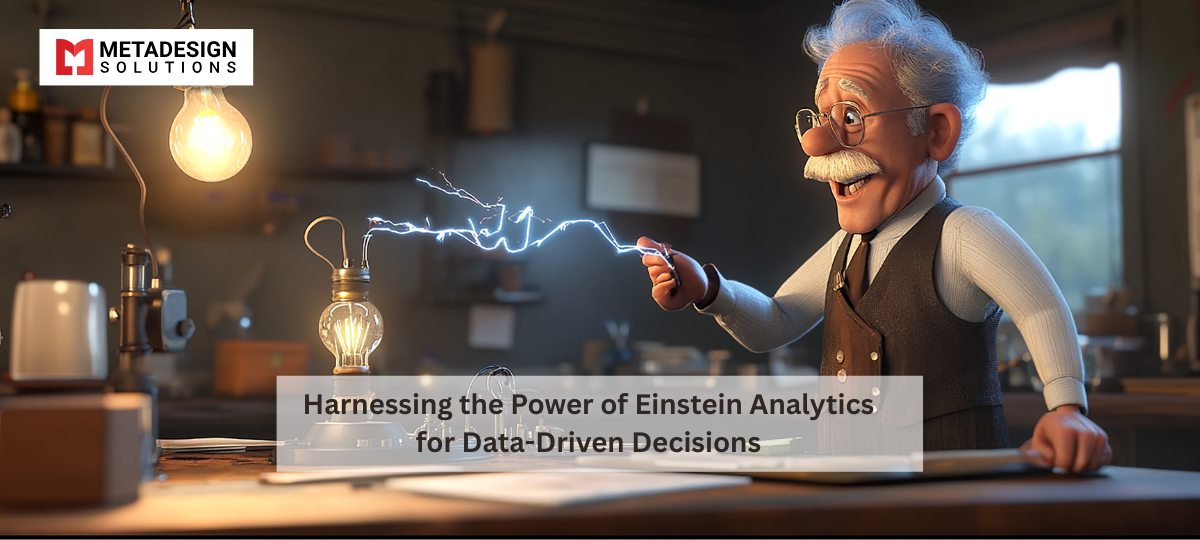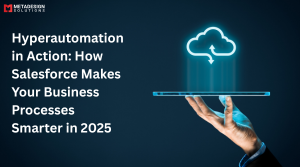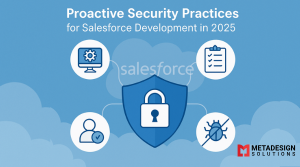In today’s data-rich environment, transforming data into actionable insights is crucial for strategic decision-making. Einstein Analytics, now known as Tableau CRM, provides advanced analytics capabilities within Salesforce. With my extensive experience, I’d like to explore how you can leverage these tools to unlock valuable business insights.
At MetaDesign Solutions, we help organizations implement and optimize Einstein Analytics to make informed, data-driven decisions through our Salesforce Development Services.
Understanding Einstein Analytics
Einstein Analytics, now part of Tableau CRM, is a powerful cloud-based platform that provides businesses with advanced tools for analyzing Salesforce and external data. It enables users to create interactive, visually rich dashboards and gain AI-powered insights that drive smarter, data-informed decisions. By integrating seamlessly into the Salesforce ecosystem, it transforms raw data into valuable intelligence that can be leveraged across all departments for improved performance and business outcomes.
Key Features:
Advanced Analytics: Go beyond standard reports with advanced data modeling and complex calculations. Unlock in-depth insights from your data, facilitating the creation of robust, customized reports that cater to specific business needs.
AI Integration: Leverage artificial intelligence to drive predictive analytics and automated insights. Einstein Analytics provides smart recommendations and identifies trends to help forecast future business scenarios, guiding decision-making processes.
Data Visualization: Create interactive and visually intuitive dashboards that allow users to explore and analyze data interactively. Visualizing complex data makes it easier for stakeholders to understand and act upon the insights.
Enhancements and New Features:
Einstein Discovery: This powerful feature offers automated analytics that helps uncover patterns, identify key insights, and generate predictions from large datasets. By recognizing trends and anomalies, it assists organizations in making faster, more informed decisions.
Connectors: Einstein Analytics offers improved integrations with external data sources such as ERP systems, marketing tools, and other business applications, enabling a unified view of all relevant data.
Templates and Apps: Pre-built analytics apps and templates for specific industries and use cases accelerate implementation. These templates help businesses tailor their analytics efforts without starting from scratch, making adoption faster and easier.
Need Powerful, Interactive Dashboards?
Schedule a call to build tailored Einstein Analytics visualizations that drive smarter decisions.
Implementing Einstein Analytics: A Step-by-Step Guide
Step 1: Define Objectives
Before diving into analytics, it’s essential to set clear objectives for what you want to achieve. This will guide the entire process, from data collection to final insights.
Business Questions: Identify the key business questions you want to answer. What are you trying to analyze or predict? Understanding the problem you’re trying to solve helps in selecting the right data and analysis techniques.
Data Sources: Determine which datasets are necessary to answer the identified questions. These could come from Salesforce, external systems, or even social media platforms. The goal is to ensure the data aligns with the business objectives.
Step 2: Prepare Data
Proper data preparation is crucial for generating accurate insights. Data that is clean, accurate, and well-organized leads to better analysis.
Data Integration: Use connectors and integration tools to bring in external data if needed. This might include data from systems like ERP, marketing platforms, or external databases. The goal is to create a unified view of data for comprehensive analysis.
Data Modeling: Define datasets, their relationships, and ensure they are structured for analysis. This could involve creating tables, fields, or views within Salesforce or Tableau CRM. Strong data modeling ensures that your data is accurate and accessible for meaningful analysis.
Step 3: Build Dashboards
Dashboards are the visual representation of your data and insights. A well-designed dashboard can tell the story of your data and make it easy to interpret for decision-makers.
Design Layouts: Use the dashboard designer tools in Tableau CRM to create layouts that are visually appealing and aligned with your business goals. Keep the layout simple yet functional to allow for easy understanding of key metrics.
Add Widgets: Incorporate various widgets like charts, tables, graphs, and filters to present data in an engaging and interactive format. Widgets allow users to dive deeper into the data and gain actionable insights.
Interactivity: Enable users to drill down into data by adding interactivity. This could include clicking on a chart to view detailed records or applying filters to view specific data segments. The goal is to make the dashboard dynamic and user-friendly.
Step 4: Implement Einstein Discovery
Einstein Discovery uses AI-powered analytics to find patterns and predict future outcomes. This step turns raw data into actionable insights and drives smarter business decisions.
Create Stories: Let the system analyze the data and automatically uncover patterns, correlations, and trends. Stories provide a narrative around your data, making it easier to understand and act on.
Review Insights: Understand the key drivers behind your data. This could include identifying anomalies, hidden patterns, or factors that have the greatest impact on your business.
Apply Predictions: Integrate predictive analytics directly into your business processes. Use predictive scores to improve decision-making, such as predicting customer behavior, sales forecasts, or operational efficiencies.
Step 5: Deploy and Share
Once the analytics setup is complete, it’s time to share insights with key stakeholders and ensure the solution is actively used.
User Access: Set permissions based on user roles and responsibilities. Share dashboards with stakeholders across the organization, allowing them to access the insights they need to make informed decisions.
Training: Educate users on how to interact with the analytics platform, interpret the data, and use the insights in their day-to-day work. Training is key to ensuring widespread adoption and effective use of the platform.
Best Practices
Implementing and maintaining an analytics solution involves ongoing effort and attention to detail.
Data Quality: Ensure your data is clean, accurate, and up-to-date. Quality data is the foundation of reliable insights.
Performance Optimization: Optimize data queries and dashboard performance for fast, efficient data retrieval. Slow dashboards can hinder user experience and decision-making.
Continuous Improvement: Regularly update your analytics to reflect changing business needs, new data sources, and emerging trends. A good analytics strategy evolves over time to meet new challenges.
Overcoming Challenges
Every analytics implementation faces challenges, but these can be overcome with careful planning and execution.
Complex Data Structures: Simplify complex data structures where possible, using data modeling techniques to make them more accessible for analysis.
User Adoption: Encourage user adoption by providing comprehensive training and demonstrating the value of the analytics platform. Highlight how data-driven decisions can drive business success.
Licensing Costs: Plan and budget for the necessary licenses. While advanced analytics tools like Einstein Discovery and Tableau CRM offer powerful capabilities, their costs should be factored into the overall implementation budget to ensure scalability and long-term success.
How MetaDesign Solutions Can Help
We offer comprehensive services to help you maximize the value of Einstein Analytics.
Our Offerings:
- Strategy Development: Align analytics initiatives with business goals.
- Implementation: Set up and configure Einstein Analytics tailored to your needs.
- Data Integration: Connect and consolidate data from various sources.
- Training and Support: Empower your team to utilize analytics effectively.
A Success Story
We assisted a healthcare organization in leveraging Einstein Analytics to improve patient care.
Challenge: They needed insights into patient data to enhance treatment outcomes.
Solution: We implemented dashboards that visualized patient metrics and integrated predictive analytics to identify at-risk patients.
Outcome: The organization improved patient satisfaction and reduced readmission rates.
Turn Data into Insights
Harnessing the power of Einstein Analytics can transform your decision-making processes.
Let’s Unlock Your Data’s Potential
If you’re ready to enhance your analytics capabilities, we’re here to guide you.
Contact us at sales@metadesignsolutions.com to start the conversation.
At MetaDesign Solutions, we’re dedicated to helping you make smarter, data-driven decisions.
Related Keyphrase:
#EinsteinAnalytics #DataDrivenDecisions #AnalyticsForBusiness #SalesforceEinstein #DataInsights #AIAnalytics #BusinessIntelligence #AnalyticsPower #SalesforceAnalytics #DataDrivenStrategy #BusinessAnalytics #EinsteinAI #DataVisualization #AnalyticsTools #SmartDecisions #PredictiveAnalytics #AIForBusiness #DataScience #EinsteinInsights #SalesforceData #AIAnalytics #AnalyticsInAction #BusinessOptimization #AnalyticsSolutions #EinsteinForData #DataAnalytics



